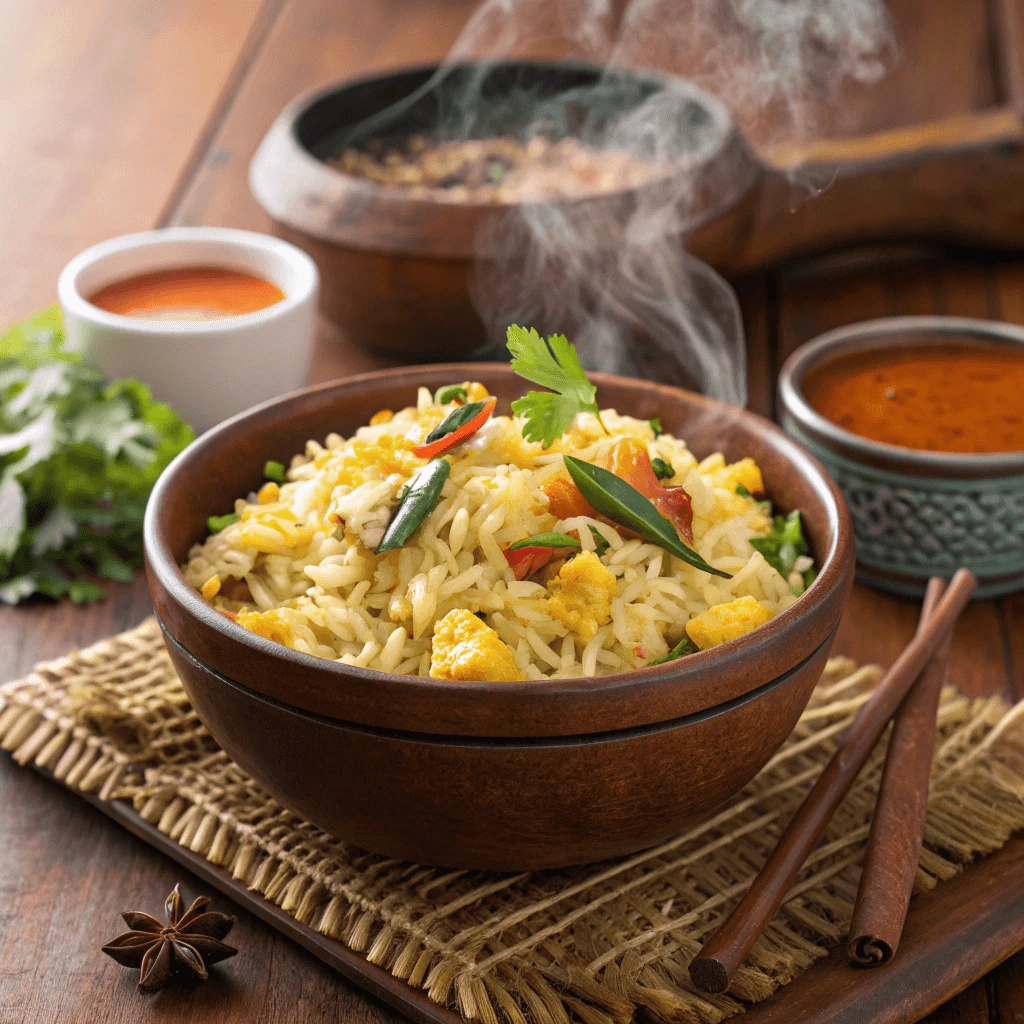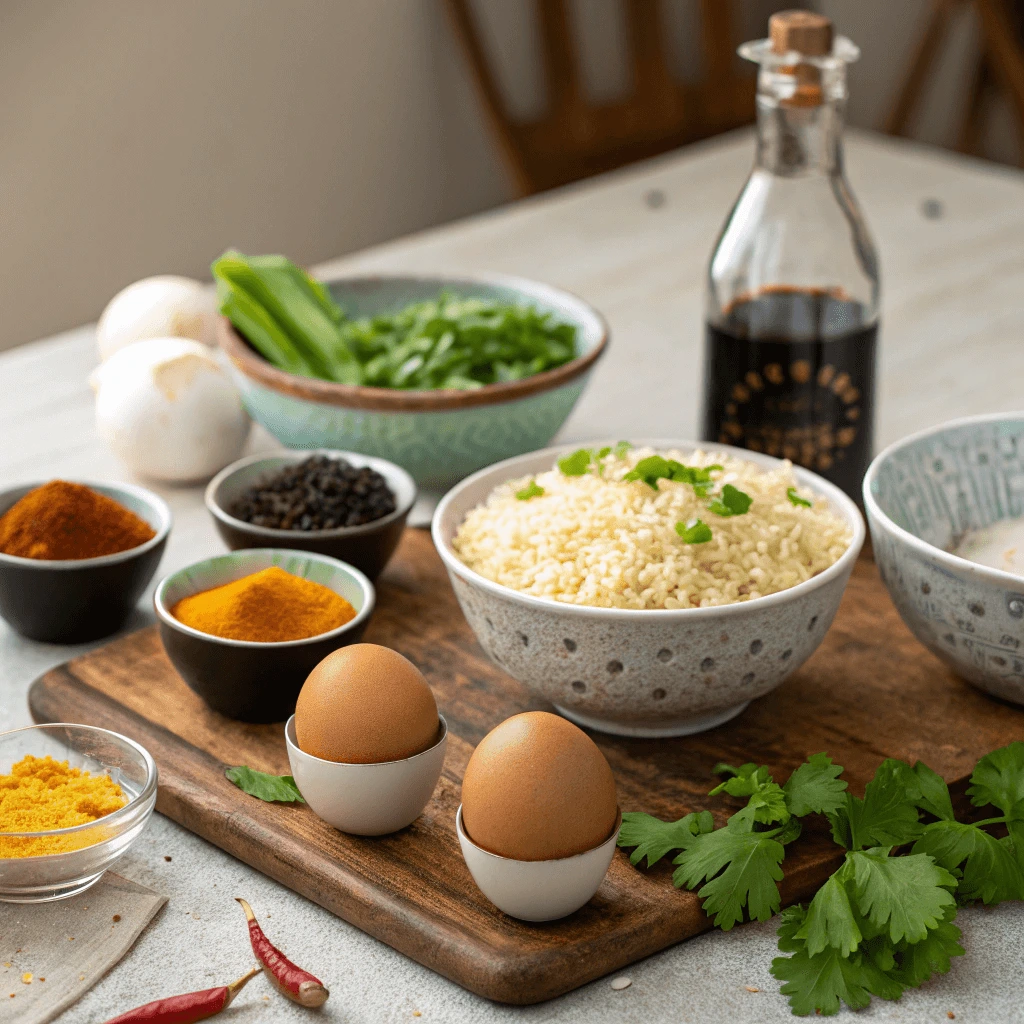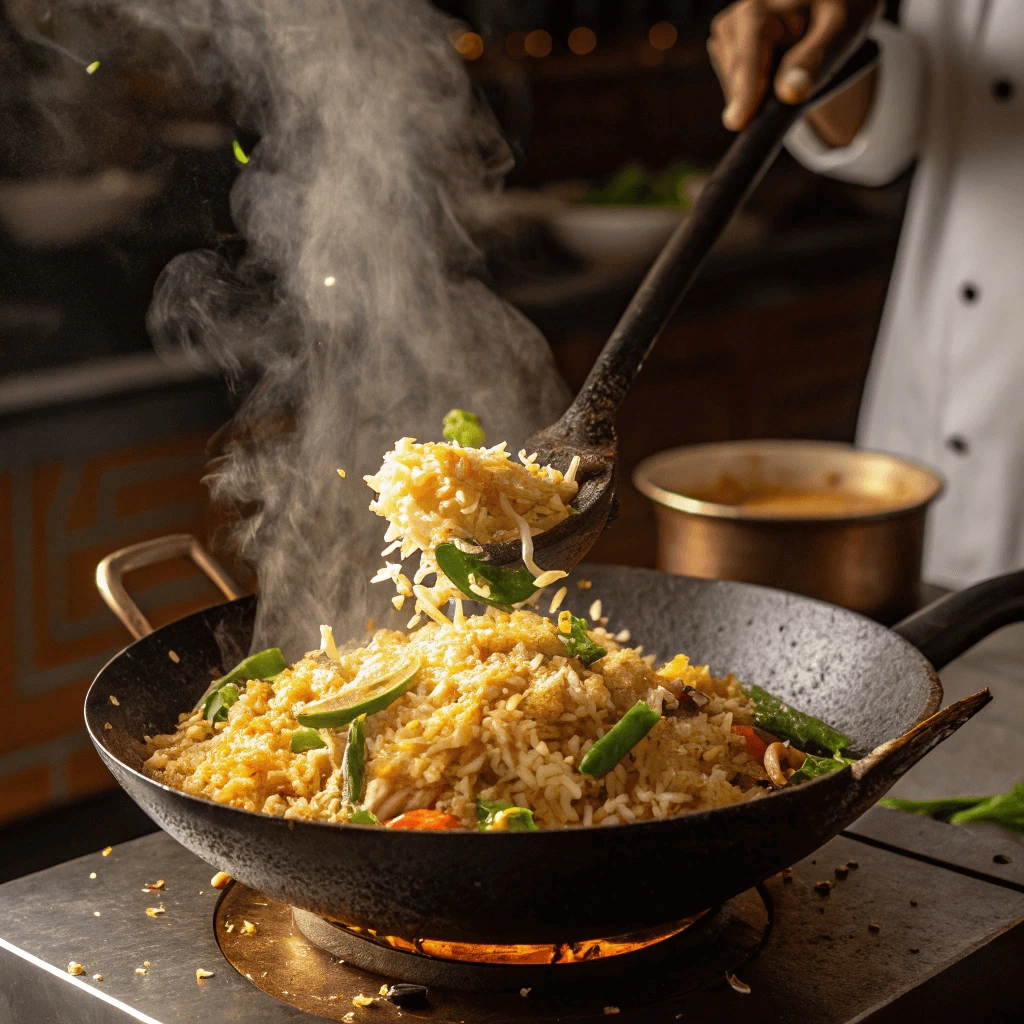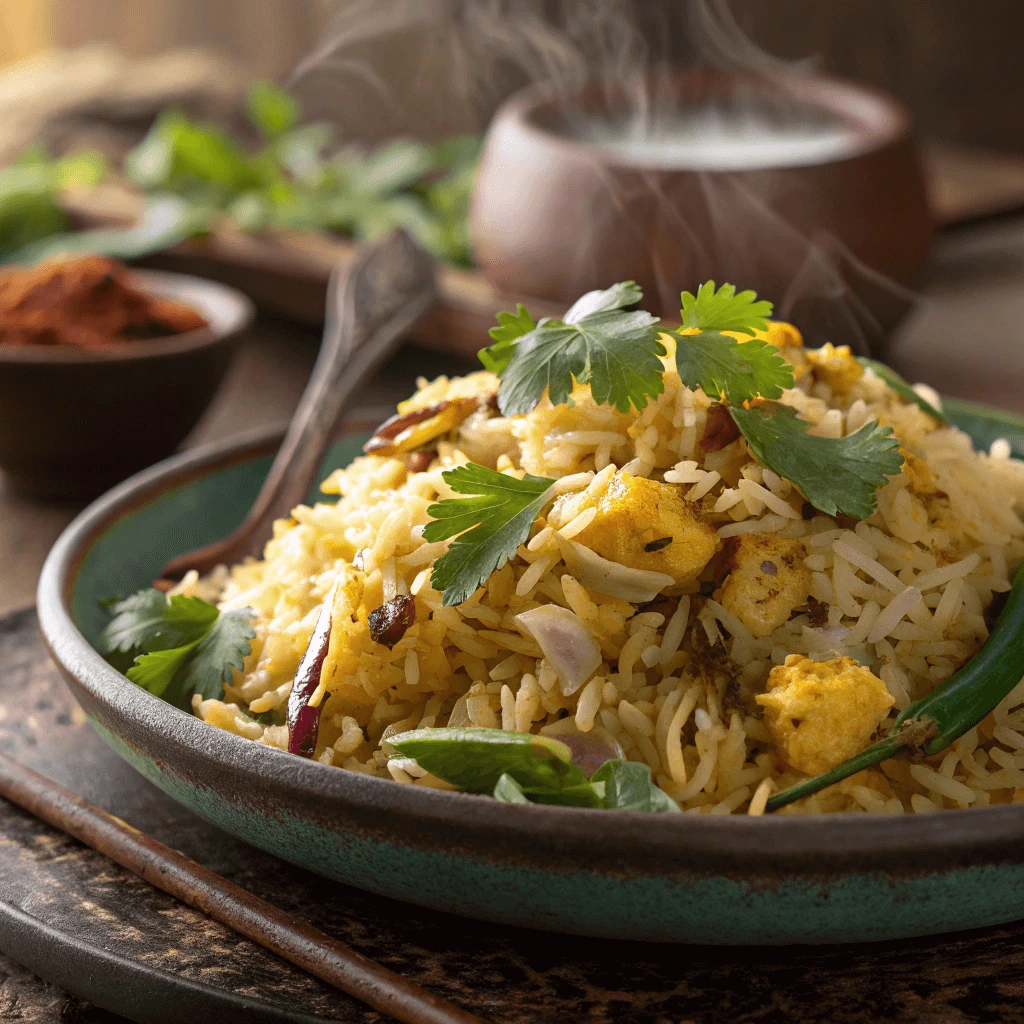If you love bold and flavorful South Indian cuisine, then this Authentic Anjappar Egg Fried Rice recipe is a must-try! Inspired by the famous Anjappar Chettinad Restaurant, this dish brings together fragrant basmati rice, perfectly scrambled eggs, and a blend of aromatic spices for a delicious and satisfying meal.
What makes this recipe special? It’s quick, easy, and packed with rich Chettinad flavors—all without the need for complicated ingredients. Whether you’re looking for a hearty lunch, a simple dinner, or a restaurant-style meal at home, this egg fried rice is the perfect choice, making it a great option for those with dietary preferences.
Follow along for a step-by-step guide to recreating this flavorful dish in your own kitchen! 🍛✨
What Makes Anjappar Egg Fried Rice So Unique?

Origins of Anjappar and Chettinad Cuisine
Anjappar: A Name Synonymous with Chettinad Flavors
Anjappar is a globally recognized restaurant chain that began in Chennai in 1964. Its mission was simple: to introduce authentic Chettinad cuisine to a wider audience. Over the years, it has expanded across India and internationally, earning a loyal following for its bold, flavorful dishes like Anjappar egg fried rice.
The Heritage of Chettinad Cuisine
Chettinad cuisine originates from the Chettiar community in Tamil Nadu. Known for their rich cultural traditions, the Chettiars created a unique cooking style using sun-dried vegetables, aromatic spices, and flavorful masalas. Staples include fennel seeds, black pepper, kalpasi (stone flower), cinnamon, and star anise—spices that form the base of many traditional dishes.
A Fusion of Tradition and Innovation
What makes Anjappar special is its ability to preserve tradition while embracing modern taste. Dishes like their signature egg fried rice blend Chettinad flavors with Indo-Chinese techniques. The result is a spicy, smoky fried rice made with basmati rice, scrambled eggs, and bold seasonings. This flavorful fusion is what sets Anjappar apart and makes its egg fried rice a favorite among food lovers.
Difference Between Chinese and Anjappar-Style Fried Rice
Flavor and Spice Levels
Chinese fried rice usually features a mild, balanced taste. It relies on light soy sauce, sesame oil, and scallions for seasoning. In contrast, Anjappar-style fried rice brings bold and spicy flavors. Chettinad spices such as black pepper, green chilies, and ginger-garlic paste create a distinct heat and aroma that defines its character.
Ingredients and Rice Variety
Chinese recipes often use jasmine or short-grain rice, which tends to be stickier. On the other hand, Anjappar fried rice uses long-grain basmati rice, prized for its fluffy texture and aroma. Chinese cooks commonly use peanut or sesame oil, while Anjappar recipes prefer vegetable or sunflower oil infused with Indian spices to add depth.
Cooking Techniques and Egg Preparation
In Chinese fried rice, eggs are typically scrambled and cooked along with the rice, blending smoothly into the dish. Anjappar egg fried rice cooks the eggs separately, folding them in later to maintain a distinct texture. Both styles rely on high heat and fast stir-frying, but Anjappar’s method layers spices gradually, enhancing complexity and richness.
The combination of Indian spices with classic stir-fry methods makes Anjappar egg fried rice uniquely flavorful and exciting.
Signature Flavors in South Indian Egg Fried Rice
Bold Use of Spices
South Indian egg fried rice stands out due to its bold and vibrant spice blend. Black pepper and green chilies add a noticeable heat that awakens the palate. Fresh ginger and garlic paste contribute a sharp, fragrant base that complements the richness of the eggs and rice. These spices combine to create a distinct, layered flavor profile that differentiates it from other fried rice varieties.
Aromatic Ingredients That Enhance Taste
Curry leaves and mustard seeds often make a cameo, lending a subtle earthiness and crunch to the dish. The use of fresh spring onions adds a mild sweetness and a refreshing crunch, balancing the spicy heat. Additionally, a dash of soy sauce or dark sauce introduces a slight umami flavor, tying the ingredients together harmoniously.
Texture and Cooking Style
The rice in South Indian egg fried rice is cooked separately to achieve a fluffy, non-sticky texture. Eggs are scrambled softly and folded gently into the rice, ensuring they remain tender and moist. The spices are tempered in hot oil before mixing with rice and eggs, which intensifies their aroma and flavor. This careful layering of ingredients results in a dish that bursts with flavor and offers a satisfying mouthfeel.
Ingredients for Authentic Anjappar Egg Fried Rice

Choosing the Right Rice: Basmati vs. Other Varieties
Why Basmati Rice is the Preferred Choice
Basmati rice is famous for its long, slender grains and fragrant aroma. When cooked, it stays fluffy and separate, which makes it ideal for fried rice recipes like Anjappar egg fried rice. The light texture prevents clumping, allowing the flavors of spices and eggs to coat each grain evenly. This rice variety enhances the dish’s authentic taste and gives it a restaurant-style finish.
Other Rice Varieties and Their Impact
Some cooks use jasmine or short-grain rice, which tend to be stickier and softer. While jasmine rice offers a floral aroma, its sticky texture may cause the fried rice to clump together, reducing the dish’s lightness. Short-grain rice absorbs flavors differently and may not retain the fluffy texture that basmati provides. Using these varieties can alter the final texture and overall experience of the dish.
Tips for Preparing Rice for Fried Rice
It’s important to use day-old cooked rice or properly cooled fresh rice for fried rice. Freshly cooked rice contains more moisture and can become mushy during stir-frying. Cooling the rice allows excess moisture to evaporate, helping grains stay separate when tossed with spices and eggs. Additionally, rinsing rice before cooking removes excess starch, further preventing clumping.
Must-Have Spices and Condiments
Black Pepper and Green Chilies: The Heat Sources
Black pepper plays a crucial role in Anjappar egg fried rice, giving it a sharp, earthy heat that’s characteristic of Chettinad cuisine. Fresh green chilies add an extra layer of spiciness and a slight crunch. Both spices are carefully added during cooking to balance heat and flavor without overpowering the dish.
Ginger-Garlic Paste: The Flavor Base
Ginger-garlic paste is used liberally to create a strong aromatic foundation. It’s sautéed in hot oil to release its pungent aroma before other ingredients are added. This paste infuses the fried rice with warmth and complexity, making the dish more savory and rich.
Soy Sauce and Other Condiments
Soy sauce is an essential condiment that adds a salty, umami depth to the dish. While traditional Anjappar recipes may use a darker soy sauce or a blend of sauces, many cooks adjust this to taste for a balanced flavor. Some versions include a dash of vinegar or lemon juice to brighten the rice and cut through the richness. Fresh spring onions or coriander leaves are often sprinkled on top as a fresh finishing touch.
Optional Add-ins: Veggies, Proteins, or Heat
Adding Vegetables for Texture and Nutrition
Many cooks enhance Anjappar egg fried rice by including vegetables like carrots, bell peppers, peas, and spring onions. These veggies add vibrant colors, crunch, and extra nutrients. You can quickly sauté them before adding rice to maintain their crispness. Incorporating vegetables also helps balance the rich spices with a fresh, earthy flavor.
Protein Boosters Beyond Egg
Although eggs provide a good protein base, some prefer to add other proteins like diced paneer, tofu, or cooked chicken for a heartier meal. These options can be cooked separately or stir-fried with the spices to absorb the bold flavors of the dish. Including these proteins not only enriches the texture but also increases satiety.
Adjusting the Heat Level
To customize the spice level, extra green chilies, red chili powder, or a pinch of black pepper can be added. For those who prefer milder flavors, reducing or omitting these ingredients works well too. Some cooks also like to finish the dish with a squeeze of lemon juice or a sprinkle of fresh coriander to brighten the heat and add freshness.
Step-by-Step Recipe for Easy Anjappar Egg Fried Rice

Prepping the Ingredients for Quick Cooking
Selecting and Washing the Rice
Start by choosing good-quality basmati rice for the best texture. Rinse the rice thoroughly under cold water until the water runs clear to remove excess starch. This prevents the rice from sticking together during cooking. After rinsing, soak the rice for about 20 minutes to help the grains cook evenly and remain fluffy.
Chopping Vegetables and Aromatics
Prepare all vegetables and aromatics before starting the cooking process. Finely chop green chilies, spring onions, and any optional vegetables like carrots or bell peppers. Mince fresh ginger and garlic or use ready-made ginger-garlic paste. Having these ingredients ready speeds up the stir-fry and ensures even cooking.
Scrambling the Eggs Separately
To achieve fluffy eggs in your fried rice, scramble them separately in a hot pan with a little oil. Cooking eggs separately prevents them from overcooking and allows you to control their texture. Once cooked, set them aside and add them to the rice towards the end for a perfect blend of flavors.
Wok Techniques for Perfect Texture
Preheat the Wok Properly
To achieve the ideal texture in your Anjappar egg fried rice, always preheat your wok until it is very hot. A well-heated wok sears ingredients quickly, locking in flavors and preventing sogginess. Avoid overcrowding the wok, as this lowers the temperature and causes ingredients to steam rather than fry.
Use High Heat and Quick Stir-Frying
Maintaining high heat throughout cooking is crucial. The fast stir-fry method ensures that the rice grains stay separate and develop a slight crispness on the edges. Constant stirring prevents burning and promotes even cooking. Use a wooden spatula or a wok spatula to toss the rice and eggs efficiently.
Layering Flavors Gradually
Start by tempering spices like mustard seeds, black pepper, and green chilies in hot oil to release their aromas. Then, add aromatics such as ginger-garlic paste and spring onions before incorporating the rice. Fold in the scrambled eggs at the end to preserve their softness. This gradual layering technique ensures every bite carries a balanced mix of flavors and a perfect texture.
Final Touches for Authentic Flavor
Garnishing with Fresh Ingredients
Adding fresh garnishes elevates the dish and brings brightness to the rich flavors. Finely chopped spring onions or coriander leaves are sprinkled on top just before serving. This fresh touch adds color, aroma, and a slight crunch that contrasts perfectly with the soft fried rice.
Drizzling Soy Sauce and Adjusting Seasoning
Soy sauce is drizzled lightly over the fried rice to introduce a subtle umami depth. It’s important to add it gradually while tossing the rice, so the seasoning spreads evenly without overpowering the dish. Taste-testing is recommended to adjust saltiness and spice levels according to personal preference.
Incorporating Citrus for Balance
A squeeze of fresh lemon or lime juice is often added at the end to balance the spices and oils. The citrus acidity cuts through the richness, brightening the overall flavor. Some cooks also like to include a dash of vinegar as an alternative, enhancing the tangy undertones of the dish.
Healthy Tips and Customizations
Making a Lighter Version of Egg Fried Rice
Use Less Oil or Healthier Oils
One of the simplest ways to lighten your egg fried rice is to reduce the amount of oil used. Instead of traditional vegetable oil, try healthier options like olive oil or avocado oil, which provide good fats and add subtle flavors. Using a non-stick pan or wok also helps reduce oil usage without sticking.
Choose Brown or Multigrain Rice
Switching from white basmati rice to brown or multigrain rice increases fiber content and nutrients. These whole grain varieties help you feel full longer and support digestion. Although they require a slightly longer cooking time, their nutty flavor adds a delicious twist to your egg fried rice.
Add More Vegetables and Lean Proteins
Increase the vegetable content by adding diced carrots, peas, bell peppers, or spinach to bulk up the dish with vitamins and minerals. You can also include lean proteins like tofu or egg whites to keep the meal light but satisfying. These additions reduce overall calorie density while maintaining flavor and texture.
Protein-Rich Additions for a Balanced Meal
Enhancing Nutritional Value with Paneer and Tofu
Paneer and tofu are excellent plant-based protein options that complement the flavors of Anjappar egg fried rice. Paneer’s mild taste absorbs the spices well, while tofu offers a soft texture and neutral flavor, making it versatile. Both can be cubed and lightly sautéed before being mixed into the fried rice to boost protein content and make the dish more filling.
Incorporating Lean Meats and Seafood
Adding lean meats such as chicken breast or turkey introduces extra protein without overwhelming the dish with fat. Small, evenly cut pieces cooked separately ensure tenderness and even flavor distribution. Seafood like shrimp or prawns can also be quick-cooked and added for a delicious twist. These proteins enrich the dish while keeping it light and satisfying.
Boosting Protein with Egg Whites and Legumes
Using egg whites instead of whole eggs reduces fat but retains high-quality protein. Scrambling egg whites separately and folding them into the rice creates a fluffy texture and keeps the dish healthy. For a vegetarian protein boost, cooked legumes such as chickpeas or lentils can be stirred in. They add texture and fiber, making the meal more balanced and nutritious.
Gluten-Free or Low-Sodium Options
Using Gluten-Free Soy Sauce Alternatives
Traditional soy sauce contains wheat, which is not suitable for a gluten-free diet. Fortunately, tamari sauce offers a great gluten-free substitute. It delivers the same rich, salty umami flavor without compromising taste. When preparing Anjappar egg fried rice, replace soy sauce with tamari to keep the dish gluten-free while preserving authenticity.
Reducing Sodium Without Sacrificing Flavor
High sodium content can be a concern for many people, especially those with hypertension. To lower sodium levels, use low-sodium or reduced-salt soy sauce alternatives. You can also cut back on added salt during cooking and enhance flavor with fresh herbs like coriander and spices such as black pepper and green chilies, which add heat and complexity naturally.
Incorporating Fresh Ingredients for Enhanced Taste
Using fresh aromatics like ginger, garlic, and green chilies boosts flavor without relying on excessive salt. Squeezing a little lemon or lime juice at the end adds brightness and helps balance flavors, making low-sodium versions taste vibrant and satisfying. Preparing your own spice blends rather than store-bought mixes allows full control over sodium content and ensures freshness.
FAQs and Serving Suggestions
Best Side Dishes to Pair with Anjappar Egg Fried Rice
Chettinad Chicken Curry: A Spicy Classic
Chettinad chicken curry complements Anjappar egg fried rice perfectly with its rich, spicy flavors. The slow-cooked chicken is simmered in a blend of freshly ground spices, including black pepper, star anise, and cinnamon. This hearty curry adds depth and warmth, balancing the relatively lighter fried rice.
Refreshing Cucumber Raita for Cooling Contrast
To counterbalance the heat of the fried rice and curry, a cool cucumber raita makes an ideal side. This yogurt-based dish is mixed with diced cucumbers, roasted cumin powder, and fresh coriander. The creamy texture and mild flavors help soothe the palate, making the meal more enjoyable and balanced.
Crispy Papadums or Pappad: Crunchy Accompaniment
Crispy papadums add a delightful crunch and texture contrast to the soft fried rice. These thin, spiced wafers are typically roasted or fried until golden and crispy. Served alongside, they offer a satisfying bite and a subtle smoky flavor that enhances the overall dining experience.
Can I Make This Ahead of Time?
Preparing Anjappar Egg Fried Rice in Advance
You can definitely make Anjappar egg fried rice ahead of time. Preparing the rice and scrambling the eggs in advance saves time on busy days. Cook the rice fully and allow it to cool completely before storing it in an airtight container. This step prevents moisture buildup, which keeps the rice fluffy when reheated.
Proper Storage to Maintain Freshness
Store the prepared egg fried rice in the refrigerator within two hours of cooking to avoid bacterial growth. Use airtight containers to preserve aroma and prevent drying out. It’s best to consume the refrigerated fried rice within 2-3 days for optimal taste and safety.
Reheating Tips for Best Results
When reheating, use a hot wok or skillet to quickly toss the fried rice with a splash of oil. This method revives the rice’s texture and reactivates the spices, making it taste almost as fresh as when first cooked. Avoid microwaving for long periods, as it may cause the rice to become mushy or dry. Adding a few fresh chopped spring onions or a squeeze of lemon juice after reheating can brighten the flavors.
How to Recreate the Restaurant Experience at Home
Use the Right Cookware and Techniques
To capture the authentic texture and flavor of Anjappar egg fried rice, use a heavy-bottomed wok or non-stick pan. Preheat the pan thoroughly to ensure quick, high-heat cooking that seals in the flavors. Stir-fry the ingredients rapidly to achieve the signature slightly smoky aroma and fluffy rice texture found in restaurants.
Serve on Traditional or Stylish Dinnerware
Presentation plays a big role in the dining experience. Use stainless steel plates or banana leaves to mimic the traditional serving style of South Indian restaurants. Alternatively, choose simple yet elegant dinnerware that highlights the vibrant colors of the fried rice. Garnish generously with fresh spring onions and lemon wedges to add a professional touch.
Pair with Complementary Sides and Ambiance
Enhance the meal by serving classic accompaniments like tangy cucumber raita, spicy Chettinad chicken curry, or crispy papadums. Playing soft South Indian instrumental music or light Indo-Chinese fusion tunes can set the mood. Lighting candles or dimming lights slightly adds warmth, making the home dining atmosphere feel special and inviting.
Conclusion
Making authentic Anjappar egg fried rice at home is both easy and rewarding. This recipe combines traditional Chettinad spices with simple stir-fry techniques to deliver bold, flavorful, and aromatic fried rice. Using basmati rice, fresh eggs, and key ingredients like black pepper and green chilies ensures you capture that signature taste. Whether for a quick meal or special occasion, this dish brings restaurant-quality flavors to your kitchen in minutes. Give it a try and enjoy a delicious South Indian classic anytime!
